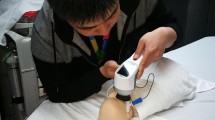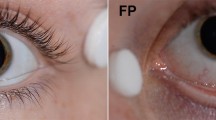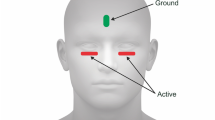Abstract
Purpose
Diopsys® NOVA™ is a novel full-field electroretinography (ffERG) device that can make rapid measurements of retinal electrophysiologic function. Diagnosys® Espion 2™ is a clinical gold-standard ERG device. This study aimed to investigate whether light-adapted Diopsys® NOVA™ fixed-luminance flicker ffERG magnitude and implicit time (converted from phase) measurements correlate with light-adapted Diagnosys® Espion 2™ flicker ffERG amplitude and implicit time measurements, respectively.
Methods
Twelve patients (22 eyes) with various retinal and uveitic diseases underwent light-adapted Diagnosys® Espion 2™ and Diopsys® NOVA™ fixed-luminance flicker testing. Diopsys® magnitude and implicit time (converted from phase) measurements were compared to Diagnosys® amplitude and implicit time measurements, and a Pearson correlation was used to evaluate any existing correlation. Groups were also compared using generalized estimating equations. Bland–Altman plots were utilized to determine agreement between the comparison groups.
Results
Age of patients ranged from 14 to 87 years. 58% (n = 7/12) of patients were female. A significant, positive correlation (r = 0.880, P < 0.001) was observed between magnitude (Diopsys®) and amplitude (Diagnosys®) measurements. Amplitude increases by 6.69 µV for each 1 µV increase in Magnitude (p-value < 0.001). A statistically significant, strong positive correlation was observed between Diopsys® implicit time measurements (converted from phase) and Diagnosys® implicit time measurements (r = 0.814, p-value < 0.001). For each 1 ms increase in Diopsys® implicit time, Diagnosys® implicit time increases by 1.13 ms (p-value < 0.001).
Conclusions
There is a statistically significant positive correlation between light-adapted Diopsys® NOVA™ fixed-luminance flicker amplitude and Diagnosys® flicker magnitude values. Additionally, there is a statistically significant positive correlation between Diopsys® NOVA™ fixed-luminance flicker implicit time (converted from phase) and Diagnosys® flicker implicit time values. These results imply that the Diopsys® NOVA™ module, which utilizes the nonstandard shortened International Society for Clinical Electrophysiology of Vision (ISCEV) ERG protocol, can produce reliable light-adapted flicker ffERG measurements.






Similar content being viewed by others
References
Robson AG, Nilsson J, Li S, Jalali S, Fulton AB, Tormene AP, Holder GE, Brodie SE (2018) Iscev guide to visual electrodiagnostic procedures. Doc Ophthalmol 136(1):1–26. https://doi.org/10.1007/s10633-017-9621-y
Gundogan FC, Tas A, Sobaci G (2011) Electroretinogram in hereditary retinal disorders. Electroretinograms pp 5–132.
Hassan-Karimi H, Jafarzadehpur E, Blouri B, Hashemi H, Sadeghi AZ, Mirzajani A (2012) Frequency domain electroretinography in retinitis pigmentosa versus normal eyes. J Ophthalmic Vis Res 7(1):34–38
Vincent A, Robson AG, Holder GE (2013) Pathognomonic (diagnostic) ergs A review and update. Retina 33(1):5–12. https://doi.org/10.1097/IAE.0b013e31827e2306
Good PA, Searle AE, Campbell S, Crews SJ (1989) Value of the erg in congenital nystagmus. Br J Ophthalmol 73(7):512–515. https://doi.org/10.1136/bjo.73.7.512
Khanna S, Martins A, Oakey Z, Mititelu M (2019) Non-paraneoplastic autoimmune retinopathy: multimodal testing characteristics of 13 cases. J Ophthalmic Inflamm Infect 9(1):6. https://doi.org/10.1186/s12348-019-0171-1
Johnson MA, Marcus S, Elman MJ, McPhee TJ (1988) Neovascularization in central retinal vein occlusion: electroretinographic findings. Arch Ophthalmol 106(3):348–352. https://doi.org/10.1001/archopht.1988.01060130374025
Bresnick GH, Palta M (1987) Temporal aspects of the electroretinogram in diabetic retinopathy. Arch Ophthalmol 105(5):660–664. https://doi.org/10.1001/archopht.1987.01060050078042
Tahara K, Matsuura T, Otori T (1993) Diagnostic evaluation of diabetic retinopathy by 30-hz flicker electroretinography. Jpn J Ophthalmol 37(2):204–210
Ponjavic V, Andreasson S (2001) Multifocal erg and full-field erg in patients on long-term vigabatrin medication. Doc Ophthalmol 102(1):63–72. https://doi.org/10.1023/a:1017589301855
Zoumalan CI, Zamanian RT, Doyle RL, Marmor MF (2009) Erg evaluation of daily high-dose sildenafil usage. Doc Ophthalmol 118(3):225–231. https://doi.org/10.1007/s10633-008-9148-3
Creel DJ (2019) Electroretinograms. Handb Clin Neurol 160:481–493. https://doi.org/10.1016/B978-0-444-64032-1.00032-1
Wolpert K, Tsang S. Electroretinography. Electroretinograms. IntechOpen; 2011.
Resende AF, Sanvicente CT, Eshraghi H, Garcia A, Pickel K, Zhang Q, Waisbourd M, Jay Katz L (2019) Test-retest repeatability of the pattern electroretinogram and flicker electroretinogram. Doc Ophthalmol 139(3):185–195. https://doi.org/10.1007/s10633-019-09707-5
Robson AG, Frishman LJ, Grigg J, Hamilton R, Jeffrey BG, Kondo M, Li S, McCulloch DL (2022) Iscev standard for full-field clinical electroretinography (2022 update). Doc Ophthalmol 144(3):165–177. https://doi.org/10.1007/s10633-022-09872-0
Maleki A, Ueberroth JA, Manhapra A, Walsh M, Asgari S, Chang PY, Anesi SD, Foster CS (2022) Fixed-luminance and multi-luminance flicker electroretinography parameters in patients with early active birdshot chorioretinopathy. Ocul Immunol Inflamm 30(1):129–135. https://doi.org/10.1080/09273948.2020.1797113
Proakis J, Manolakis D (1996) Digital signal processing. Principles, algorithms, and applications, 4th edn. Prentice Hall.
Tang J, Hui F, Hadoux X, Sarossy M, van Wijngaarden P, Coote M, Crowston JG (2018) A comparison of the reteval sensor strip and dtl electrode for recording the photopic negative response. Transl Vis Sci Technol 7(6):27. https://doi.org/10.1167/tvst.7.6.27
Brodie SE (2014) Tips and tricks for successful electroretinography in children. Curr Opin Ophthalmol 25(5):366–373. https://doi.org/10.1097/ICU.0000000000000093
Hobby AE, Kozareva D, Yonova-Doing E, Hossain IT, Katta M, Huntjens B, Hammond CJ, Binns AM, Mahroo OA (2018) Effect of varying skin surface electrode position on electroretinogram responses recorded using a handheld stimulating and recording system. Doc Ophthalmol 137(2):79–86. https://doi.org/10.1007/s10633-018-9652-z
Lapkovska A, Palmowski-Wolfe AM, Todorova MG (2016) Comparing dtl microfiber and neuroline skin electrode in the mini ganzfeld erg. BMC Ophthalmol 16:137. https://doi.org/10.1186/s12886-016-0311-4
Liew G, Mitchell P, Wang JJ, Wong TY (2006) Fundoscopy: To dilate or not to dilate? BMJ 332(7532):3. https://doi.org/10.1136/bmj.332.7532.3
Wood JM, Garth D, Grounds G, McKay P, Mulvahil A (2003) Pupil dilatation does affect some aspects of daytime driving performance. Br J Ophthalmol 87(11):1387–1390. https://doi.org/10.1136/bjo.87.11.1387
Kato K, Kondo M, Sugimoto M, Ikesugi K, Matsubara H (2015) Effect of pupil size on flicker ergs recorded with reteval system: new mydriasis-free full-field erg system. Invest Ophthalmol Vis Sci 56(6):3684–3690. https://doi.org/10.1167/iovs.14-16349
Mobasserian A, Zaidi M, Halim S, Hwang JJ, Regenold J, Akhavanrezayat A, Karaca I, KhojastehJafari H, Yavari N, Matsumiya W, Yasar C, Than NTT, Uludag G, Do D, Ghoraba H, Nguyen QD (2022) Effect of pupil size on fixed-luminance flicker full-field electroretinogram magnitude. Clin Ophthalmol 16:3733–3740. https://doi.org/10.2147/opth.S382207
Wroblewski JJ, McChancy C, Pickel K, Buterbaugh H, Wieland T, Gonzalez A (2020) Reproducibility of fixed-luminance and multi-luminance flicker electroretinography in patients with diabetic retinopathy using an office-based testing paradigm. J Diabetes Sci Technol 14(6):1095–1103
Funding
No funding was received for this research.
Author information
Authors and Affiliations
Corresponding author
Ethics declarations
Conflict of interest
Stanford University has received research support through the availability of the Diopsys® NOVA™ device for research purposes. All authors certify that they have no affiliations with or involvement in any organization or entity with any financial interest (such as honoraria; educational grants; participation in speakers' bureaus; membership, employment, consultancies, stock ownership, or other equity interest; and expert testimony or patent-licensing arrangements), or non-financial interest (such as personal or professional relationships, affiliations, knowledge or beliefs) in the subject matter or materials discussed in this manuscript.
Ethical approval
All procedures performed in studies involving human participants were in accordance with the ethical standards of the Stanford University School of Medicine and with the 1964 Helsinki declaration and its later amendments or comparable ethical standards.
Informed consent
Informed consent was obtained from all individual participants included in the study.
Human rights and statement
This article does not include any studies involving animals conducted by the authors.
Additional information
Publisher's Note
Springer Nature remains neutral with regard to jurisdictional claims in published maps and institutional affiliations.
Supplementary Information
Below is the link to the electronic supplementary material.
Rights and permissions
Springer Nature or its licensor (e.g. a society or other partner) holds exclusive rights to this article under a publishing agreement with the author(s) or other rightsholder(s); author self-archiving of the accepted manuscript version of this article is solely governed by the terms of such publishing agreement and applicable law.
About this article
Cite this article
Regenold, J., Doan, H.L., Ghoraba, H. et al. Evaluation of correlation between Diopsys® NOVA™ fixed-luminance flicker ERG and Diagnosys® Espion 2™ flicker ERG parameters. Doc Ophthalmol 146, 257–266 (2023). https://doi.org/10.1007/s10633-023-09934-x
Received:
Accepted:
Published:
Issue Date:
DOI: https://doi.org/10.1007/s10633-023-09934-x




